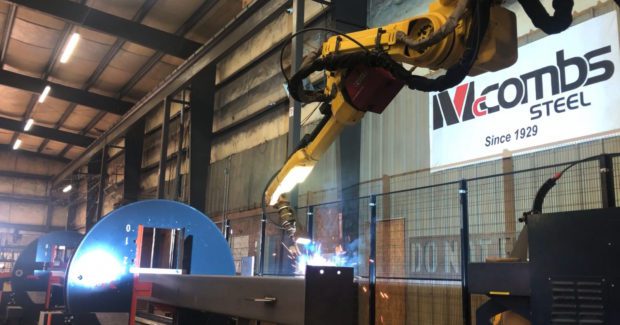Robotic Welding Cuts Structural Steel Fabrication Costs in Half
Robotic welding is much more common for automotive applications than structural steel, where beam weight and variability vastly complicate handling and programming. To combat skilled-labor shortages, a North Carolina fabricator is using PC-controlled hardware that automates programming.
Posted: August 24, 2020
BY JAMES FIGY
Among all other industries, construction uses the majority of steel produced globally. Beams for buildings require reliable, high-precision welding to ensure structural integrity and public safety.
McCombs Steel Co. Inc. in Statesville, N.C., is certified by the American Institute of Steel Construction (AISC) and fabricates and erects structural steel and miscellaneous metals. As such, the company faces the challenges of maintaining high quality, implementing lean manufacturing and meeting project timelines every day. The BeamMaster robotic welding system from AGT Robotics helps McCombs meet these challenges.
“The lack of experienced personnel led to overworking our staff, which is unacceptable,” says President Mac McCombs. “The BeamMaster, which is nicknamed Bruce, has increased safety, quality and throughput.”
Based in Trois-Rivieres, Quebec, AGT Robotics was founded in 1992 as a general automation integrator, but now specializes almost exclusively in robotic welding. Introduced in 2015, the BeamMaster system uses AGT’s Cortex software with built-in artificial intelligence (AI) and a proprietary simulation engine to optimize weld schedules. Relying on PC-based control technology, the standard version comprises two or more servo-driven beam rotators, a Fanuc Arc Mate 120iC articulated robot that moves parallel to the beam along a track, and an operator station with a multitouch control panel. The circular rotators handle beams 4 inches to 48 inches wide, 90 feet long, and weighing 10,000 pounds. For maximum welding efficiency, the rotators turn 360 degrees to expose all surfaces on W beams and HSS closed rectangular columns.
While similar robotic welding systems have been widely adopted for automotive applications, very few are designed for structural steel. AGT Robotics recognized this untapped market was a significant opportunity, but one with unique challenges, according to General Manager and Co-owner Louis Dicaire.
“The automotive business produces a few parts maybe 100,000 times, so just a few robots repeat the same tasks for years,” he says. “In structural steel, even though parts are similar, the beams have different widths, lengths, sections and accessories in an infinite number of combinations. That has slowed implementation of robotics in this industry.”
Through its inherent flexibility, the BeamMaster – distributed as the Ocean Challenger by Ocean Machinery in the U.S. – offers an optimal solution.
Flexibility For Automated Welding And Programming
Robotics can offset a shortage of qualified welders, but constant programming of custom parts often requires additional controls engineers, which are also difficult to find in today’s job market. To avoid this, AGT wanted to produce a system that would automate programming as well as welding.
“The structural steel industry relies on Tekla CAD software, so we built a plug-in that exports 3D beam models from Tekla into our Cortex software, which automatically generates movements including sequencing and flipping of the beam,” says AGT Automation & Robotics Specialist François Béland. All joint types are covered, whether multi- or single-pass, a quarter-inch weld or a half-inch weld.
“Not only is the operation automated, but the automation programming is also automated,” Dicaire says. “You could say that it’s automation squared.”
Transferring these software capabilities to a real-time machine control environment, however, required a similarly flexible automation platform. Hardware and software modularity was important to ensure BeamMaster systems could be easily scaled up or down as required, because a fabrication shop might want to add rotators or even a second robot to increase throughput. And because the system is designed for shops with limited engineering resources, the platform needed to provide robust remote support capabilities for troubleshooting and updates.
EtherCAT Opens Up Communications
While searching for an EtherCAT industrial Ethernet system master controller in 2015, AGT’s engineering team identified PC-based control technologies from Beckhoff Automation as a comprehensive solution and began working with Beckhoff Regional Sales Manager Ted Sarazin to standardize the BeamMaster design.
“The openness of the Beckhoff platform, from the company that invented EtherCAT and TwinCAT automation software, was key for AGT,” Sarazin says.
While BeamMaster systems can be quite large, AGT sought compact controller and I/O options to ensure small control cabinet footprints while remaining cost-competitive. Because EtherCAT is deterministic and doesn’t require IP addresses for each device, says Béland, it speeds up commissioning through automatic configuration of devices on the network and offers reliable real-time communication.
Regarding hardware, the BeamMaster uses space-saving 8- and 16-channel EtherCAT I/O terminals, EtherNet/IP bus couplers to interface with Fanuc robot controllers, and TwinSAFE terminals for integrated functional safety. Several safety zones with light curtains ensure operators approach the beam to perform quality inspection only when the robot isn’t active. The curtains connect to TwinSAFE terminals using the TÜV-certified Safety over EtherCAT (FSoE) protocol to communicate safety data via a “black channel” method over the same EtherCAT network used for standard communication.
A Universal Platform For Robotic Welding
Beyond EtherCAT, AGT leverages many solutions from the Beckhoff platform. TwinCAT 3 provides deterministic control from a software-based master for BeamMaster. Programming of all functions, from PLC and motion control to safety and HMI, is directly integrated into Microsoft Visual Studio. Engineers can select the language they know best or that makes the most sense for the project, whether it’s IEC 61131-3 with object-oriented extensions, function blocks or computer science standards.
“We can develop our own applications – using .NET, for instance – that will communicate directly with the PLC,” Béland says. “Most importantly, all code is easy to reuse and customize from one system to another.”
All PLC code and auxiliary software runs on a CX5130 embedded PC from Beckhoff, connected to a CP2918 multitouch control panel as the operator interface. The DIN rail-mounted machine controller has a dual-core Intel Atom processor with 4 GB DDR3 RAM.
“The CX5130 delivers enough processing power for all motion and sequence planning tasks, even if the system uses two robots and additional beam rotators,” Dicaire says. “Another strength is that it’s a PC, so we can run other applications alongside the PLC, such as the HTML5-based HMI and SQL databases.” The CP2918 combines an 18.5-inch widescreen panel with integrated push buttons and an industrial-hardened form factor suited for fabrication shop environments.
Beyond the robot equipped with a Lincoln Electric AutoDrive welding source, all other motion control takes place with AX5000 series servo drives and AM8000 servomotors from Beckhoff. These provide closed-loop control for accurate positioning of the beam.
“From motion control to PLC programming and integration of third-party software and robots, the BeamMaster shows how scalable and incredibly open the Beckhoff platform is,” Sarazin says.
Automatic Results With PC-Based Automation
The development of Cortex software and careful system design of BeamMaster using off-the-shelf components from Beckhoff resulted in significant advantages for AGT. Programming the first system took two months, but now, with easy code reuse, it takes half a day. Standardizing on Beckhoff also cut component costs in half compared to previous solutions while providing more capabilities and options for customization.
“While Beckhoff automation technologies are high-performing and very reliable, the company’s support is also very responsive,” Dicaire says. The inherent connectivity of PC-based control allows AGT to provide support and updates quickly. In addition, AGT includes an Android tablet with each BeamMaster so customers can send images or video to its engineers in Canada for help with troubleshooting. “All in all, the move to EtherCAT and PC-based automation has been an excellent decision for us and for our customers, such as McCombs.”
Before investing in the BeamMaster, McCombs Steel met with AGT and several customers, and carefully considered where it would fit in the shop’s three production bays. The system has become invaluable and contributed to growth since it went live in September 2019. “It’s exceeded expectations,” says Mac McCombs. “We’ve experienced a safer work environment, higher-quality construction materials and increased throughput through round-the-clock welding.”
McCombs commissioned a second BeamMaster in spring 2020.
























